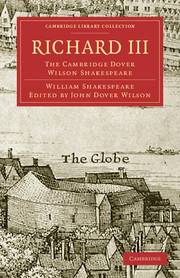THE STAGE HISTORY
Published online by Cambridge University Press: 07 September 2010
Summary
The play, to judge by the apparent frequency of performance, has been one of the most popular in the canon. But this is deceptive, since in its period of greatest vogue, the eighteenth century, and even down to Henry Irving, a perversion by Colley Cibber was presented, in whole or part, in the place of Shakespeare. The present survey will cover the stage-history of both the original play, and of its eighteenth-century supplanter.
The words ‘lately Acted by the Right Honourable the Lord Chamberlaine his seruants’ which appear on the title-page of the first Quarto are repeated down to 1605, and duly altered in 1612 and 1622 to ‘lately Acted by the King Maiesties Seruants’. But no record of the performances has yet been discovered. On 16 November 1633, it was played ‘by the K. players’ at Court before King Charles and the Queen; but this is the only notice of the play before the closing of the theatres in 1642. Yet its popularity in Shakespeare's time and after is abundantly attested by the repeated Quartos, and by many allusions. Meres in Palladis Tamia (1598) lists it as one of the six plays proving Shakespeare to be ‘most excellent’ in tragedy ‘among the English’ as Seneca ‘among the Latines’. The next year John Weever in his Epigrammes pairs ‘Richard’ with ‘Romeo’ in an eulogy of Shakespeare's ‘issue’.
- Type
- Chapter
- Information
- Richard IIIThe Cambridge Dover Wilson Shakespeare, pp. xlvi - lxiiPublisher: Cambridge University PressPrint publication year: 2009First published in: 1954



